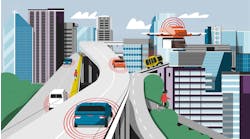The implementation of connected and automated vehicle (CAV) technologies at the Florida Department of Transportation (FDOT), as part of the Florida Connected and Automated Vehicle Initiative (Florida-CAVI), has led to a collaboration with the University of Florida to create a test bed called the I-STREET. Among its initiatives is the Gainesville Autonomous Transit Shuttle (GAToRS) project. The GAToRS study presents conclusions for planning and deploying successful autonomous transit systems. Study aspects included crash data and traffic volumes; traffic characteristics; system elements including traffic signals, roundabouts, parallel parking, bike lanes and bus stops; and operational, safety and security factors.
A review of automated vehicles (AVs) and CAVs, and the role of automation in mobility, particularly public transport, suggests that AVs and CAVs are extending to other emerging areas including smart transportation cities. With an increasing focus on vehicle safety, congestion, and travel behavior impacts from AVs and the potential for autonomous bus fleets to drop operating costs by roughly 50%, the move toward AV shuttles in the public transport market could be a subject of intense research and practice over the next decade. While auto manufacturers look to create viable CAV systems, in-depth research continues in both the technical and experimental areas such as path and speed planning for automated public transport vehicles (APTV), electric vehicles for the elderly, and AVs for first- and last-mile transportation needs. While many works of research point to the possibilities and benefits of AVs and CAVs, few works illustrate the challenges of running such systems, especially from a roadway operations and traffic management perspective. Thus, the purpose of this work, in part, is to present the feasibility and traffic analysis to recognize and highlight any traffic or safety conditions which should be accommodated in the GAToRS project. The objective is to ensure the safe and efficient operation of this APTV project in and around the University of Florida (UF) campus and the city of Gainesville.
Figure 1
The CAVI
The Florida Department of Transportation’s (FDOT) rich legacy of transportation innovation has reached a new inflection point, and is gaining momentum throughout every district and many of the largest metropolitan areas in Florida. Through Florida-CAVI, FDOT and its partners are committed to the continuing deployment of CAV projects and initiatives to support the safety and mobility needs of Florida’s road users. This includes linking the many projects and initiatives together to create a comprehensive statewide program for research, development, and deployment of these transformative technologies. Through research partnerships with other agencies in the state and universities, FDOT supports multiple CAV initiatives, including the I-STREET initiative, in collaboration with UF and the city of Gainesville. Figure 1 shows various projects and initiatives that fall under FDOT-CAVI.
The Gainesville Regional Transit System (RTS), city of Gainesville and FDOT jointly developed a pilot project to implement an autonomous transit system near the UF campus and within downtown Gainesville. The proposed route for the 2-mile autonomous transit route circumnavigates the city’s Innovation Square. The transit route comprises SE 2nd Avenue (south), SW 13th Street (west), SE 4th Avenue (north) and South Main Street (east), as shown in Figure 2. The GAToRS project was initiated to explore the connectivity with the Innovation Square, and the proposed use of autonomous transit technology.
As part of this project, a feasibility study with safety and operational analysis was conducted using field reviews and data analysis. One of the primary uses of the analysis was to provide input to the development of a request for proposal for soliciting autonomous shuttles for the project.
Routes, stops and traffic control
RTS operates three bus routes through the project corridor that covers SW 2nd Avenue and SW 4th Avenue. The buses operate at varying frequencies during different times and days of the week. The annual ridership varies between 113,000 on the lowest ridership route to 651,000 on the highest with 45 and 99 hours of operation per week, respectively.
The project corridor has 26 closely spaced bus stops; 14 bus stops are along the clockwise direction and 12 are along the counterclockwise direction. The bus stops are either pullover stops or roadside stops blocking the through traffic. Most of them are provided with transit shelters. The pullover bus stops are typically within a parallel parking lane and/or outside of a bike lane.
The project corridor consists of several traffic controls such as two-way stop, four-way stop control, signalized intersections and roundabouts. There are five traffic signals, three roundabouts, three four-way stops and three mid-block crossings along the project corridor. The mid-block crossings are non-signalized crossings. (There are several other two-way stops that are not shown in Figure 3.)
Figure 2
Study approach
The study approach included multiple field reviews to identify and highlight any traffic or safety conditions that the implementation of GAToRS will need to accommodate for the safe and efficient operation of the autonomous transit system through the corridor. The study evaluated the following conditions and collected data from various sources to perform analyses on:
- Traffic volumes and crash statistics;
- Traffic modes including cars, transit, pedestrians, bicyclists, scooters and skateboards;
- Existing traffic control including traffic signal systems, stop control, roundabouts, crosswalks including mid-block crosswalks, parallel parking, bike lanes and bus stops; and
- Observations along with operational, safety and security/vandalism ratings provided by seven bus drivers with experience in the corridor.
The multilayered approach to data collection also included meetings with the city of Gainesville and RTS staff, and face-to-face interviews with the RTS drivers.
Conclusions
As lessons learned from this GAToRS feasibility study, it is important to understand the corridor and offer these details for partners to take precautions during operations:
- Consider measures to maintain consistent headways due to travel time variability: This conclusion is consistent with Ding and Chien, who observed that efficient and real-time operational control systems are desirable to maintain the required headways and mitigate service disruptions;
- Consider provisions for incident management detour routes: As APTV systems become a reality and mainstreamed, the role of transit planners becomes more significant than ever before—hence the need for considering the use of technology and smart card data for effective planning of the proposed automated transit shuttle operations;
- Consider provisions for passenger security and vandalism: Emerging research on the role of technology to deter or respond to crashes, crime, vandalism and suspicious activity point to investing in human behavior recognition methods for transit surveillance; and
- Consider provisions for signal priority: In absence of priority, the vehicle should have the provision to recognize the ‘no turn on red’ messages.
Figure 3
Project update
The GAToRS demonstration was performed in May 2018 and has been in service since mid-August. Six bus stops for phase 1 of the AV shuttle have been selected. Locations vary from existing regular fixed route service bus bays to only shuttle bus stops. The shuttle will operate under regular on-street parking conditions, and potential conflicts will be identified with the shuttle on service. During testing, the only potential conflict identified was that the vehicle will stop if it detects any movement on street-parked vehicles (e.g., open door, vehicle moving, etc.) Only one street parking space was removed to accommodate the AV bus stop in phase 1. RTS will test the challenges of left turns on phase 3 of the project.
------------
About the author:
Ponnaluri is connected vehicles and management systems engineer for the Florida Department of Transportation. Elefteriadou is Barbara Goldsby professor of civil engineering, UFTI director and interim department chair in Industrial and Systems Engineering at the University of Florida. Gomez is transit director of the Regional Transit System for the city of Gainesville.



